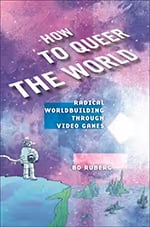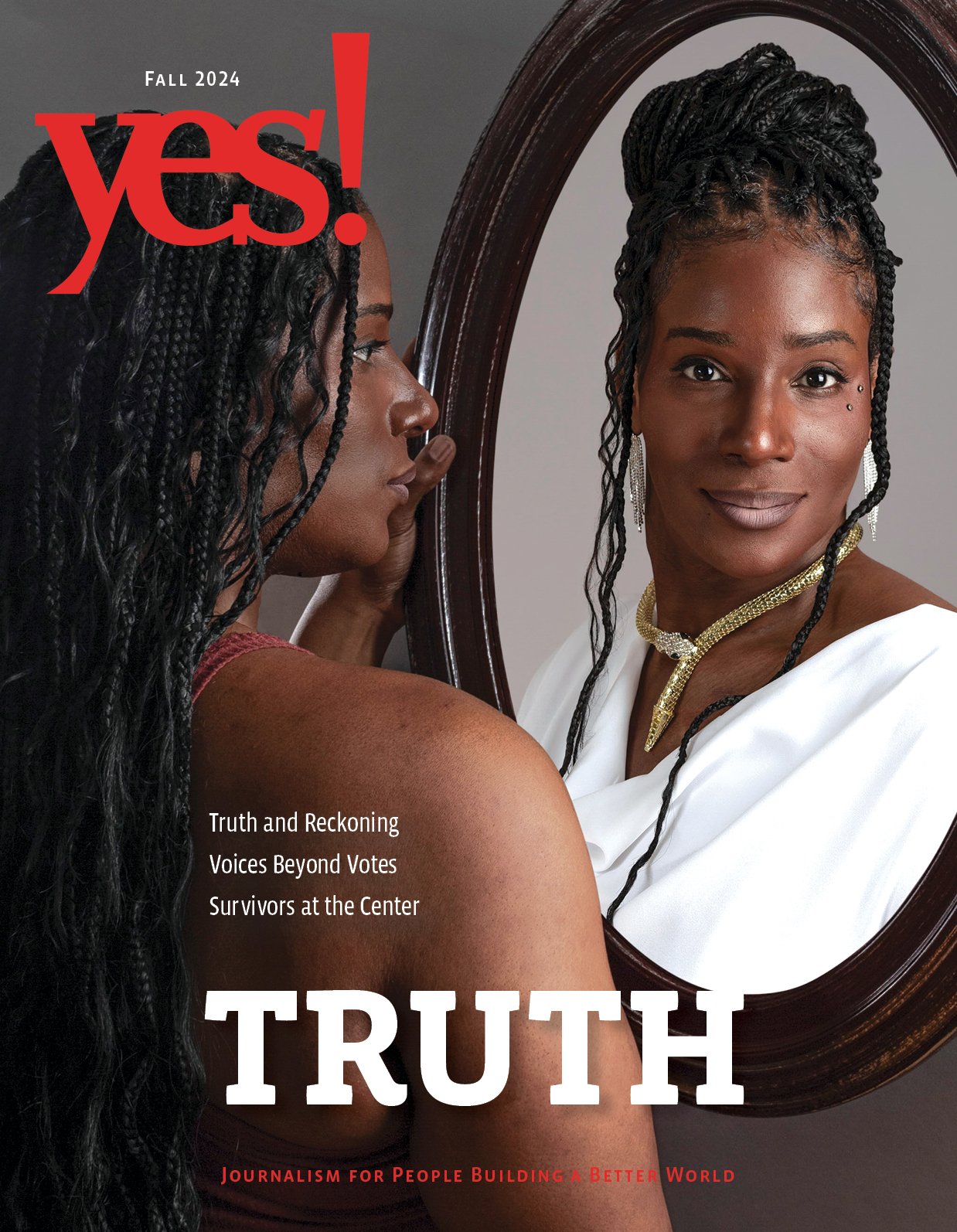Excerpt
Rebuilding the World through Queer Video Games

We stand now in a historical moment when we desperately need the ability to build new worlds. This is a moment of immense concern for the future of the world as we know it today—threatened by climate crisis, the ongoing effects of a pandemic, and a turn toward right-wing extremism across the globe—but it is also a moment of immense worldbuilding potential. For marginalized people, the pressure of this moment feels all the more palpable.
In the United States, with legal protections for LGBTQ people in jeopardy and violent incidents of racism, xenophobia, transphobia, and homophobia on the rise, it has become clear that the world we currently inhabit is broken and deeply unjust.
We now see the world before us more clearly. And this new clarity brings with it an urgent longing to deconstruct and reconstruct the world, to try again, to experiment with radically alternate ways of being, to build the world otherwise.
Before we can build the world in alternate ways, however, we need to be able to envision alternate worlds. Works of science fiction and other forms of speculative art have long been at the forefront of efforts to build new worlds through imagination. Worldbuilding of this sort is never a neutral endeavor; designing the world anew always entails resisting or reinforcing (sometimes simultaneously) existing structures of power.
The cultural stakes inherent in worldbuilding have been made particularly clear through creative and scholarly work around Afrofuturism and Black speculative worldbuilding. As performance studies scholar Jayna Brown argues in her writing about Black mystics and musicians, structures of white supremacy have placed Black communities into a “bleak and bloody dimension we are taught to call reality.” In response, Brown calls for “build[ing] alternative worlds, in this dimension and in others,” as a way to “practice alternative ways of being alive.”
In addition to turning to fiction, art, and music to find the speculative worlds that inspire us, there is another media form we should be taking closely into consideration when we look for these “alternative ways of being live”: video games. Video games have often been derided or dismissed precisely because they seem disconnected from the “real world.” Yet, in truth, the relationship between video games and the world around us is much more complex than these critiques would suggest.
As many game studies scholars have argued, video games are intimately bound up with the real world; they shape and are shaped by the conditions of their production and reception. At the same time, video games offer opportunities to inhabit worlds that differ from our own. Indeed, we can understand video games themselves as alternate worlds.
In their own ways, they are each models for other ways that the world might operate. They offer us opportunities to “question the order of things,” as the disability studies scholar Robert McRuer writes in Crip Theory: Cultural Signs of Queerness and Disability, to ask how this order has been “constructed and naturalized . . . and how it might be changed.”
Certainly, not all video game worlds offer visions of empowerment for those who are pushed to the margins. Video games are a vast and varied medium, and games culture is still marred by discriminatory attitudes toward race, sexuality, and gender. At the same time, games themselves offer powerful opportunities to experiment with strategies for rebuilding the world we currently live in, one where many forms of oppression currently reign.
Yet, through games, we can see that building (or unbuilding and rebuilding) the world necessitates a revolutionary redesign of the foundational logics and underlying operations of the world we inhabit.
Through video games, I theorize a practice that I term queer worldbuilding. Queer worldbuilding is not the same thing as building worlds that feature queer stories or communities, though such worlds themselves have immense value. Instead, queer worldbuilding describes the practice of constructing new worlds through methods, frameworks, and tools that can themselves be understood as queer.
In this spirit, I analyze video games to offer as examples of building worlds through a process that itself challenges or rewrites norms around sexuality, gender, identity, and desire. In them, we find tools for both building queer worlds and queering the world around us.
Every Video Game Is a World
This alternate vision of worldbuilding is premised on understanding video games themselves as worlds. When we think of video games and worldbuilding together, it is common to think of large-scale, expansive, story-focused games with extensively developed narratives. These games, certainly, are worlds. But so are all video games, regardless of their content. Small games are worlds. Abstract games are worlds. Puzzle games, mobile games, experimental games, absurdist games, games with no characters: All of these video games are worlds, in their own right.
Video games do sometimes contain games, but what they are, above all, is worlds: universes in miniature. Reframing video games as worlds opens up new opportunities for making sense of the cultural meaning that games contain.
If games are worlds, then the importance of competition, achievements, and technological prowess fades into the background. In its place, what comes to hold meaning in a video game is its qualities as a space for existing. In this game world, who has power? Who is afforded freedom, and who is placed under constraint? How do beings connect with one another?
The spirit of video game worldbuilding has much in common with the spirit of queerness. Both describe a mode of imagining alternate ways of being in the world. As I and my fellow queer game studies scholars have argued elsewhere, video games are rich sites for locating and expressing queerness. While some video games (whether mainstream or independent) contain the presentation of LGBTQ identities, a great many more contain queer meaning—offering themselves as opportunities for exploring queer play, engaging with queer design, or undertaking queer analysis.
Insisting on the queerness of video games, in its many forms, is a way to reclaim a medium that has long been exclusionary to queer people. To say that video games can model queer worlds is to expand on this reclamation, to move beyond making a place for queer people in the world of video games by insisting that video games can aid us in making the world itself more queer.
There are many ways in which queer worlds manifest themselves in video games. Multiple AAA games of the sort that engage in elaborate narrative worldbuilding now prominently feature queer characters. One high-profile example is The Last of Us Part II (Naughty Dog, 2020), which includes a lesbian protagonist and a transgender side character and was the recipient of a 2021 GLAAD Award for Outstanding Video Game.
Beyond the sphere of mainstream video games, the rise of queer avant-garde game makers has brought with it an explosion of indie video games whose worlds are directly structured around queer experience. Mattie Brice has noted that white designers were centered in the early days of the queer games avant-garde, which began to take form at the start of the 2010s. Today, a growing number of these games are being made by, about, and for queer people of color.
These range from The Black Trans Archive (Danielle Brathwaite-Shirley, 2021), which wrestles with the erasure of Black trans people from documented histories, to the upbeat roller derby “rhythm ga(y)me” Skate & Date (Geneva Hayward, 2020). In Skate & Date, players skate to a musical beat in the role of Maggie, a Black femme roller derby team captain with a crush on a woman from a rival team. A game like Skate & Date creates its own vision of a queer world: a world where femmes are, as a matter of course, powerful physical competitors who romance other femmes.
Queer Video Game Worlds
Queer video game worlds also manifest themselves as queer communities. Many queer and transgender people have shared stories about using online role-playing games to explore their identities and connect with others who share similar experiences: a way of forming queer games worlds while using game worlds to understand oneself as queer. Beginning in 2012 and 2013, events like GaymerX and the Queerness and Games Conference built temporary worlds where queer people who made, studied, or simply loved video games could come together to play.
At the same time, many video game worlds that do not appear queer can be understood queerly. These worlds are places where the norms that we often mistake for universal truths—our unquestioned beliefs about how the world works, both socially and physically—are sidestepped, rewritten, or overturned. Indeed, the relationship between video games and queer worldbuilding goes deeper than the queerness of any individual game world.
Video games serve as opportunities to transform queer world-making into something concrete. They offer us playgrounds where we can reach out and touch, as trans studies scholar Susan Stryker writes in describing the process of transing, “the material truth of a potential for worlding otherwise.” They show us world-making in action.
Certainly, the queer worlds we find in video games offer us a critical entry point into imagining how we might queer the world around us. Like all queer works of art and ways of living, they are messy. Queer video game worlds are often silly, improbable, or impossible, ecstatic and joyful but also broken or mournful, posthuman and nonhuman, postapocalyptic, counterhegemonic in some ways and complicit with dominant structures of power in others.
Queer video game worlds balance the longing to fix worlds and the hunger to destroy them. These worlds are many things at once. They are an invitation to remake the world through play. They are whole universes, shrunk down to the scale of tiny dioramas, galaxies under glass. Video game worlds challenge us to question how the universe—our universe, any universe—functions.
Games will not fix a broken world. They will not save a world on the brink of collapse. But they will inspire us to explore new ways of rebuilding our world. And, when necessary, they will remind us that some worlds cannot be saved.

This excerpt, adapted from How to Queer the World: Radical Worldbuilding Through Video Games by Bo Ruberg (New York University, 2025), appears by permission of the publisher.
|
Bo Ruberg
is professor of Film and Media Studies at the University of California, Irvine. They are the author of three books, Video Games Have Always Been Queer, The Queer Games Avant-Garde: How LGBTQ Game Makers Are Reimagining the Medium of Video Games, and Sex Dolls at Sea: Imagined Histories of Sexual Technologies.
|







